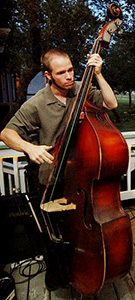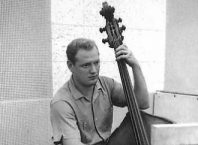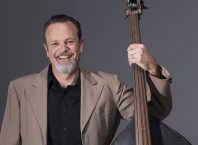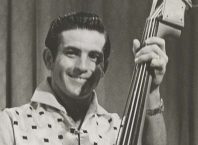In last ten years or so, Austin TX become a Mecca for slap bass players. The level of musicianship is very high and it’s hard to make a living as a musician. With such a high percentage of great slap bass players it’s even harder to have your own voice. Shortly after arriving to Austin in 1999, Ryan Gould become involved in many early jazz style bands and found himself working with such Austin luminaries as Erik Hokkanen, Floyd Domino, Wayne Hancock and The Jim Cullum Jazz Band. His previous experience of playing different music styles like traditional Irish music, bluegrass, death metal and punk rock helped him build his own unique sound. He’s one of the busiest musicians in the city playing almost every day with Erik Hokkanen and The Hip Replacements, The Jazz Pharaohs, Aunt Ruby’s Sweet Jazz Babies, Giant City/Three or The Big Jug Band.
I’m proud to present to you here, on the Art of Slap Bass, for the first time ever:
RYAN GOULD
Djordje: Hi Ryan! When did you start and what inspired you to play upright bass?
Ryan: Hello, Djordje!
I began playing string bass in 1997. My cousin needed a bassist in his bluegrass band and I had always had an interest in the instrument. I have always enjoyed learning new instruments.
So, the inspiration to play string bass was necessity and curiosity coupled with an unwillingness to challenge what seemed to be an obvious signpost.
Djordje: Before bass, you played guitar in death metal and punk; and uilleann pipes in Irish bands. Why did you make a switch and was your knowledge of other instruments helpful in the process of learning how to play bass?
Ryan: I don’t really feel like I made a conscious decision to switch from guitar or the uilleann pipes to string bass. When I bought the string bass and agreed to play with my cousin, I had every intention of keeping up with my guitar playing and my pipering. It just happened that I found myself in more situations that needed bass than guitar or pipes.
Having a background in music on other instruments definitely afforded me an easier path to learning the bass. My ears and heart were developed to a point that made picking up the bass more a question of getting over the physical aspects of a new instrument than a question of how to produce sound, form good habits, and finding practice time and inspiration.
If nothing else, I was very comfortable with the process of learning a new instrument.
Djordje: How did you learn to play upright bass?
Ryan: I’m still learning. The bass felt pretty natural in my hands and, with the knowledge of the guitar fingerboard, I could figure my way through simple bluegrass ideas right away. From that point, I started listening to as much bass playing as possible. I tried to take lessons with a guy in Philly but that didn’t really work for me.
Learning slap was a bumpy road. I couldn’t find anyone doing it in the Philly area so, I had to stumble through the process on my own trying to figure out how to produce the slap and pluck the note simultaneously.
Eventually, I started finding bands that featured good bassists and toured through the area. I picked up a few pointers from those bassists and my playing started coming together. Somewhere in that process, I had found out about the Kevin Smith and Mark Rubin video and ordered that. By the time it got to me, I had already developed a good sense of what I was doing but watching those guys play can do nothing but make a guy get better.
The move to Austin had me playing a whole mess of gigs. That’s really where I learned how to play. Three years ago I studied with a wonderful teacher and all-around good guy here in town, Glenn Schuetz. These days, I’m still listening as much as I can and playing gigs.
Djordje: How many instruments did you own, what are they and what do you currently use?
Ryan: I currently own two string basses. One is a Framus (1970s) and the other is a Pfretzschner (1940s). The Framus has a carved top; the Pfretzschner is plywood.
The Framus is what I use most of the time. I bought it about eight years ago from Mark Rubin out of Violins, Etc.
I keep the Pfretzschner at home for practice. I find having a bass out of the bag, standing in the corner just waiting to be played a lot more inviting to practice than one bagged up and waiting to go to the gig. I bought it over a year ago from a woman here in Austin who was selling it on Craigslist. Apparently, she found the thing in a dumpster!?
 Djordje: What kind of strings are you using and what is their action?
Djordje: What kind of strings are you using and what is their action?
Ryan: On the Framus, I’m using Eurosonic Lights for the E and A. I have weed-eaters on the G (.105) and D (.130). The action on the bass side is 20mm and 18mm on the other side.
The Pfretzschner has steel on the E and A (I’m not sure what they are; the seller said they were same strings on the thing when she found it in the dumpster.) I threw weed-eaters on the G and D. The action is about two millimeters lower than that of the Framus. As a result, the tone of the G and D isn’t quite as good so, the instrument doesn’t see as many gigs.
Djordje: What are the advantages of those strings over the others in your opinion and how often do you have to change them?
Ryan: I haven’t spent too much time trying out different strings. I’ve been pretty happy with my current set-up for quite a while. The Eurosonics and the weed-eaters are pretty inexpensive options. I have to trade out the Eurosonics once every two years or so; the weed-eaters last about the same. While I enjoyed the tone of guts, they broke far too often to be cost effective. The weed-eaters have a fairly decent tone, not too entirely different from the guts. And, for the price, I can put up with all the strange looks and commentary.
Djordje: How much of your professional work requires playing with the bow?
Ryan: Most of my professional work doesn’t require the bow. However, in keeping with what I know of the history, I try to use it when I feel it’s appropriate or when I’m asked. I’ll bow on a fair amount of slower two-beat tunes with The Jazz Babies; sometimes, I’ll sneak in a bowed solo. Erik Hokkanen asks me to solo with the bow from time to time.
The strings work well enough with the bow. I need to have a fair amount of rosin on the bow and a small build-up on the strings (Euros and weed-eaters) for the bowing to really work. The tone is not entirely different from what you’d expect from gut strings. Of course, it takes some practice time to get the tone.
Djordje: What came first, pizzicato, arco or slap and how did you learn the slap technique?
Ryan: Pizzicato came first. I didn’t have a bow so it seemed like the only way to get any music out of the bass. I stuck with the technique until slap stole every last bit of my focus a few months later.
Slap came into my awareness rather shortly after I picked up the instrument. I had no idea it was an option until it was pointed out to me that what I was hearing was not the bassist AND the drummer playing together; it was just the bassist!
The bow came to me right before I moved to Austin in 1999. A friend who had given up playing bass gave me his bow. I didn’t know what to do with it. I sawed away for quite a while until some of the basic ideas started showing themselves.
Djordje: What are the names that you use and what kind of different slap patterns (read more about it here) do you use in your playing?
Ryan: I haven’t spent too much time considering the naming of the slap patterns I use. It seems like a great idea, though. A little standardization would probably do us all some good.
I am definitely in agreement with you on counting the plucked note (with its slap-back) as a slap for the reasons you listed (read more about it here). Bill Johnson was really only plucking the quarter notes but Pops Foster and Milt Hinton indicate that he was the first guy to “slap” the bass. That’s good enough for me.
For the simple rhythms, the few times I’ve ever had to explain myself, I guess I’ve used terms like quarter notes (for “single slap”), eighth notes (for “double slap”), sixteenth notes (for “quadruple slap”), or triplet (for “triplet”). For the more complex rhythms, the terms you have on the site are what I’ve used and heard most often. “Gallop” and “drag” seem rather descriptive and without question.
The slap patterns you have listed are basically what I use in my soloing and in my accompaniment. I don’t really think too much about the slapping while I’m doing it. I’m allowing my hand to put together what seems to work in the moment and that tends to be the basics strung together and hopefully, coming together in some tasteful and musical manner.
Djordje: Who are your bass and more specifically slap influences?
Ryan: A list of bass influences could probably go on and on … my first bass influences were definitely Geezer Butler and Cliff Burton. Kevin Smith, Louis Vola, and Milt Hinton really hit me early on as slap influences. Very obviously, Pops Foster, Bill Johnson, and Al Morgan are the big influences on me and have been for most of the last ten years, as well as Thelma Terry, Wellman Braud, and Wilson Myers.
Djordje: Do you like any slap players nowadays?
Ryan: I’d feel very silly not mentioning Kevin Smith first. I don’t get to check him out as much as I used to but his music is always in my head. He’s one of the most tasteful players I’ve ever heard; he nails everything he plays effortlessly. And, just as important as anything musical, he’s one of the nicest human beings on the planet. Jimmy Sutton and Beau Sample are also on my list of favorites nailing the rockabilly, blues, and country styles.
Marty Eggers is one of my favorite contemporary early jazz players. I could listen to his playing for days on end. Don Mopsick is great, too. Both of these guys have made a great study of the early days and are well worth a very good listen.
One of the most moving musical experiences for me in the last five years was catching Taraf de Haidouks live. Vlad Viorel instantly vaulted to the top of my list. Wow!
There’s this guy named Djordje Stijepovic, too. You may have heard of him. He’s something else!
Djordje: It seems that you’re primarily an early jazz style player. What do you think is the reason that slap technique almost completely disappeared in jazz music after 1939?
Ryan: I’m sure there are many different reasons for slap finding its way out of jazz; I’d ask the same question of chord melody in guitar and stride in piano.
Perhaps, folks (on the playing end as well as the listening end) might have been getting tired of it? The cultural climate was changing a lot at that point. It seems fair to assume that bassists were required or chose to play more pizz for that reason alone.
Also, slap certainly has its challenges and limitations. Some players may have wanted to explore a less percussive sound and that sound may have appealed to listeners and bandleaders for any number of reasons. Could be that some guys just didn’t want to work on their slap chops?
From my perspective, I don’t believe that slap really disappeared. Pops Foster was playing nationally through the 1960s in his style; Chester Zardis was still plucking in New Orleans through the 1980s; Milt Hinton went all they way through to 2000 unquestionably mastering the art. There are still lots of us playing old style jazz bass today. It’s hard for me to think that it disappeared when I’ve been immersed it for more than a decade … and, I know I’m not the only one.
The explanation that’s most palatable to me is simply the growth of newer styles, some of which just don’t require slap as a main component of the string bass.
Djordje: Your bands Aunt Ruby’s Sweet Jazz Babies, the Jazz Pharaohs and Giant City play similar type of music and even share some members. What is the difference between them?
Ryan: There is some crossover in all three of these bands. But, to me, there is a definite difference in each. I can’t play a Babies gig the same way I play a Pharaohs gig; I can’t play a Pharaohs gig like I play a Giant City gig.
One of the differences is in the rhythm sections. JD (Giant City and Pharaohs) plays guitar differently than Frank Lee (Babies). I find myself making subtle shifts to blend better with each of these guys and all the musicianers in the different bands; that has a notable effect on the overall quality of the music.
Regarding the styles of music, The Pharaohs is more of a swing band that does some older jazz. Giant City is more of an early jazz band that plays some swing. The Jazz Babies is a band that plays more pop music from the 20s and 30s (think Tin Pan Alley).
 Djordje: You also sing lead vocals for the Jazz Babies. Singing and playing bass is almost like thinking on two parallel paths at the same time. Do you see yourself more as a singer or a bassist and is it hard to do it simultaneously?
Djordje: You also sing lead vocals for the Jazz Babies. Singing and playing bass is almost like thinking on two parallel paths at the same time. Do you see yourself more as a singer or a bassist and is it hard to do it simultaneously?
Ryan: I definitely see myself as more of a bassist than a singer. I have to think about singing while I’m doing it; I don’t really have to think too much about playing bass.
It doesn’t seem too difficult to sing and play simultaneously anymore. It was a bit of a hurdle to jump when I first made the attempt. As with anything, though, it just took some doing.
Now, the real difficulty presents itself in singing the correct lyrics!
Djordje: How often do you have a chance to play ukulele, guitar or uilleann pipes these days?
Ryan: Professionally, I don’t play any other instrument very often, at all. I have never played the uilleann pipes professionally. I have played only a few gigs as a rhythm guitarist in the last ten years. I play the uke and soprano saxophone in a jug band; that band only plays out about once a year, though. I’ve played one paying gig on the soprano sax –a New Year’s Eve parade with a New Orleans style marching brass band.
Djordje: Who are you playing with these days?
Ryan: Regularly, I play with The Jazz Pharaohs, Erik Hokkanen and The Hip Replacements, Giant City, The Giant Three, Aunt Ruby’s Sweet Jazz Babies, Frank Meyer and The Sons Of Peaches, Albanie Falletta and Her Fellas, and JD Pendley Trio.
Not as regularly, I play with The Big Jug Band, Beaumont LaGrange, The String Beans, The Dave Biller Quartet (a.k.a. Trio Gallerio), and The Walls of Jericho Brass Band.
Djordje: How do you like to record your bass?
Ryan: Luckily, most of the recording I’ve done in Austin has been with very competent sound engineers. I let them do their thing. Usually, these guys just stick a mic somewhere near the F-hole and we’re off to the races.
Djordje: What songs that you recorded would you recommend to bass players that are interested in your slap technique?
Ryan: There is an album that I did with Dave Biller called “Leroy’s Swing.” Another favorite album is “American Novelty” by Shorty Long. Both of those albums turned out great and I am really happy with them. They are both at CDBaby.
Djordje: What are your preferences for amps and pickups?
Ryan: Right now, I’m using a David Gage Realist. It was a gift from a very kind friend. The amp I’m using is an Ampeg BA-112. Nothing too exciting, I’m afraid. I prefer to use no amplification at all. I use the amp at only one of my regular gigs. Most of the work I do is acoustic.
Djordje: Do you use any other equipment when playing live?
Ryan: There’s a little bullet mic I use if necessary. Actually, I prefer the mic to an amp. It’s an Audio-Technica I bought a long time ago. I just clip it on the lower portion of the F hole and point it in between the treble foot of my bridge and the upper portion of the F hole. The mic seems to pick up the natural tone of my instrument. That’s about it for other equipment.
Djordje: You play gigs almost every day. Do you do any wrist stretches or some type of warm ups before the show?
Ryan: I do tons of wrist stretches and lots of warming up before gigs. But, those warm-ups and stretches are done constantly throughout the day. I keep a very physically active schedule with swimming and yoga at least five days a week. I’ve also spent some years now studying and practicing Alexander Technique.
All these movement disciplines (and others) combined with efficient practice during the day and a regular gig schedule keep my legs, back, neck, shoulders, arms, wrists, hands, and fingers in a pretty flexible and ready place all day. I’m limber all day and always ready to play … at least that’s what I tell myself.
Djordje: You play a lot in Austin. Are there any touring plans outside of Texas?
Ryan: There are no touring plans on the books as of right now. It would be nice to start hitting the road a little more often again, though.
Djordje: Do you have time to teach? Any plans for bass workshops?
Ryan: I do teach from time to time. I’ve taught one workshop on string bass in the last year. It went reasonably well; I’m sure there will be more in the future.
In either case, it’s a great pleasure to share my experience with the string bass and the study of its music with anyone interested. I find teaching is as helpful to my learning process as practicing on my own or taking lessons from another teacher.
Djordje: What do you suggest to younger players to practice on a daily basis?
Ryan: Every player is an individual and has his own set of hurdles to jump. I find it difficult to say that there is one particular thing that will improve any single bassist or a group of bassists. I think we all know to work on the technical basics like time, intonation, articulation, etc. and there are plenty of good methods out there to follow like Simandl, Rabbath, etc.
Perhaps the one thing that I always stress to any student is to be very aware of any tension and/or bad physical habits while playing –especially, while playing slap styles. The string bass seems to have a magnified set of repetitive strain issues. Playing with poor use of one’s body can result in some unpleasant or career ending injuries.
Really, the best advice I have is to learn lots of tunes, play a lot of gigs, and be nice to yourself, to your band mates, and to your audience.
Djordje: Thank you for finding time to do this interview and hope to see you play sometime soon!
Ryan: It’s an honor to be interviewed for the Art Of Slap Bass. Thank you for finding the time to do all this work for our art! I hope to play some music with you sometime soon!
If you want to ask Ryan Gould a question, you can do that on our forum.




